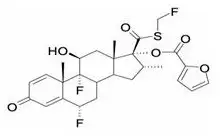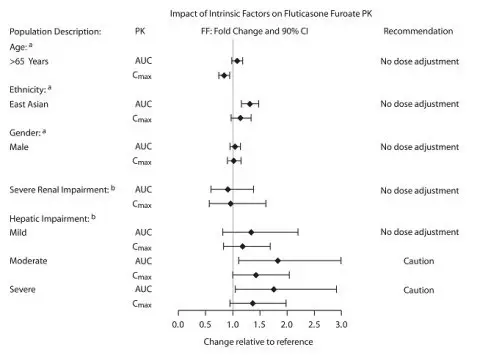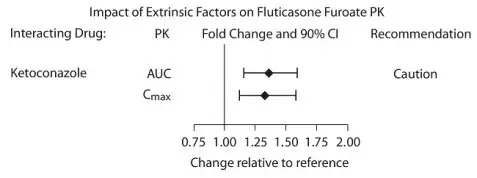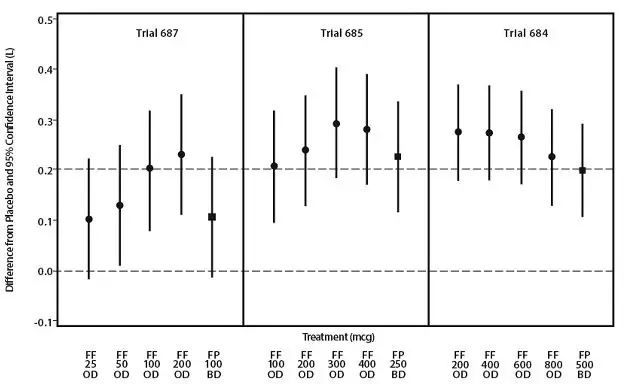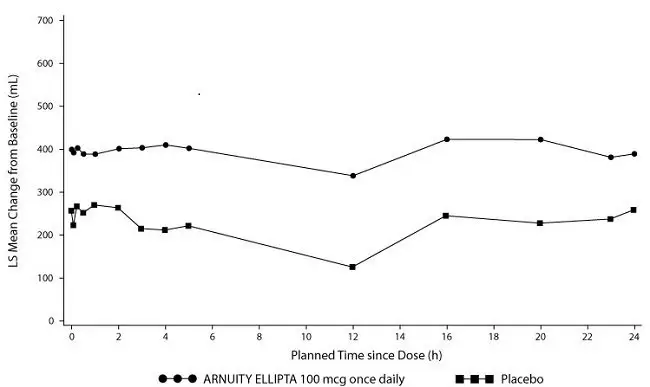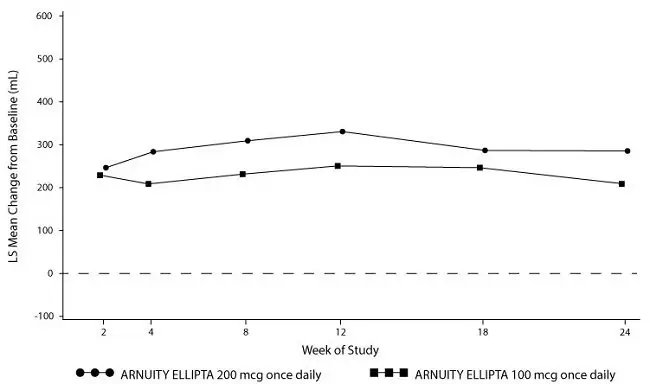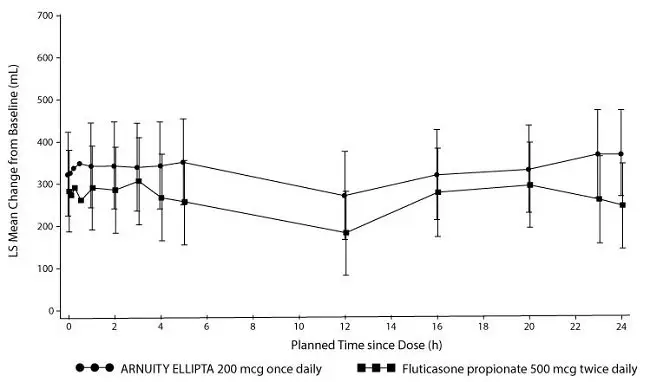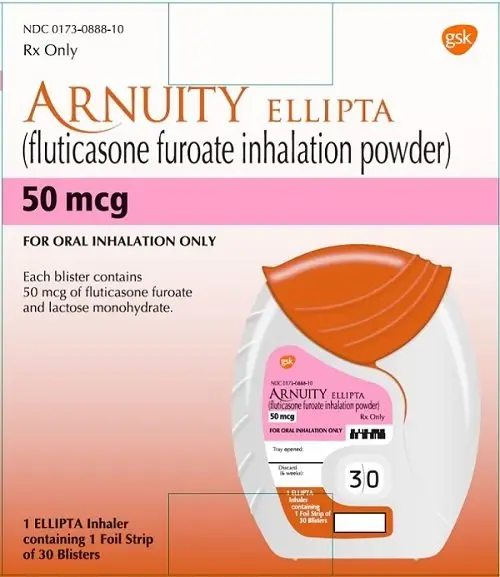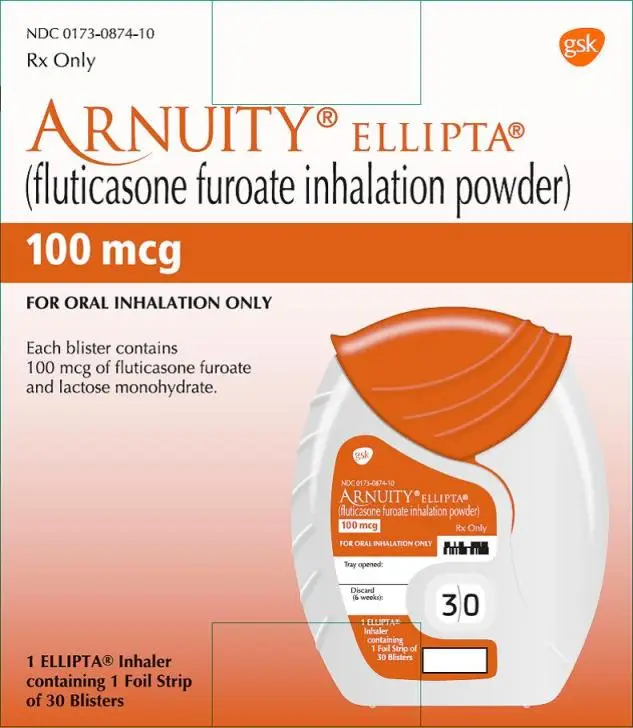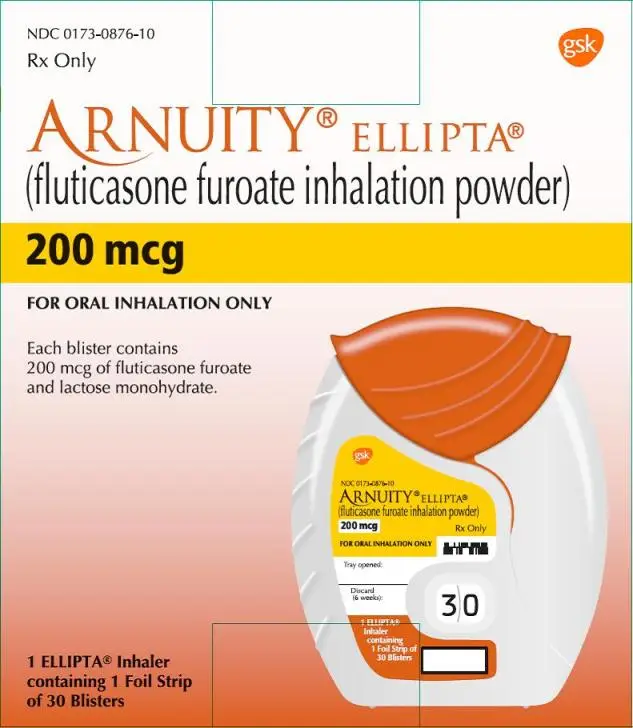Drug Detail:Arnuity ellipta (Fluticasone inhalation [ floo-tik-a-zone ])
Drug Class: Inhaled corticosteroids
Highlights of Prescribing Information
ARNUITY ELLIPTA (fluticasone furoate inhalation powder), for oral inhalation use
Initial U.S. Approval: 2014
Indications and Usage for Arnuity Ellipta
ARNUITY ELLIPTA is an inhaled corticosteroid indicated for the maintenance treatment of asthma in adult and pediatric patients aged 5 years and older. (1.1)
Limitations of Use: Not indicated for relief of acute bronchospasm. (1.1, 5.2)
Arnuity Ellipta Dosage and Administration
- •
- For oral inhalation only. (2.1)
- •
- Maintenance treatment of asthma in adult and pediatric patients aged 12 years and older: The starting dosage, 1 actuation of ARNUITY ELLIPTA 100 mcg or ARNUITY ELLIPTA 200 mcg once daily, is based on prior asthma therapy and disease severity. (2.2)
- •
- Maintenance treatment of asthma in pediatric patients aged 5 to 11 years: 1 actuation of ARNUITY ELLIPTA 50 mcg once daily. (2.2)
Dosage Forms and Strengths
Inhalation powder: A foil blister strip of powder formulation for oral inhalation. Each blister contains 50 mcg, 100 mcg, or 200 mcg of fluticasone furoate. (3)
Contraindications
- •
- Primary treatment of status asthmaticus or acute episodes of asthma requiring intensive measures. (4)
- •
- Severe hypersensitivity to milk proteins (4)
- •
- Demonstrated hypersensitivity to any ingredients. (4)
Warnings and Precautions
- •
- Candida albicans infection of the mouth and pharynx may occur. Monitor patients periodically. Advise the patient to rinse his/her mouth with water without swallowing after inhalation to help reduce the risk. (5.1)
- •
- Do not use for relief of acute symptoms. Patients require immediate re-evaluation during rapidly deteriorating asthma. (5.2)
- •
- Potential worsening of infections (e.g., existing tuberculosis; fungal, bacterial, viral, or parasitic infections; ocular herpes simplex). Use with caution in patients with these infections. More serious or even fatal course of chickenpox or measles can occur in susceptible patients. (5.3)
- •
- Risk of impaired adrenal function when transferring from systemic corticosteroids. Wean patients slowly from systemic corticosteroids if transferring to ARNUITY ELLIPTA. (5.4)
- •
- Hypercorticism and adrenal suppression may occur with very high dosages or at the regular dosage in susceptible individuals. If such changes occur, discontinue ARNUITY ELLIPTA slowly. (5.5)
- •
- If paradoxical bronchospasm occurs, discontinue ARNUITY ELLIPTA and institute alternative therapy. (5.7)
- •
- Assess for decrease in bone mineral density initially and periodically thereafter. (5.9)
- •
- Monitor growth of pediatric patients. (5.10)
- •
- Glaucoma and cataracts may occur with long-term use of inhaled corticosteroids. Consider referral to an ophthalmologist in patients who develop ocular symptoms or use ARNUITY ELLIPTA long term. (5.11)
Adverse Reactions/Side Effects
Most common adverse reactions reported in ≥5% of adult and pediatric subjects aged 12 years and older are nasopharyngitis, bronchitis, upper respiratory tract infection, and headache. (6.1)
Most common adverse reactions reported in ≥3% of pediatric subjects aged 5 to 11 years are pharyngitis, bronchitis, and viral infection. (6.1)
To report SUSPECTED ADVERSE REACTIONS, contact GlaxoSmithKline at 1-888-825-5249 or FDA at 1-800-FDA-1088 or www.fda.gov/medwatch.
Drug Interactions
Strong cytochrome P450 3A4 inhibitors (e.g., ketoconazole): Use with caution. May cause systemic corticosteroid effects. (7.1)
Use In Specific Populations
Hepatic impairment: Fluticasone furoate systemic exposure may increase in patients with moderate or severe impairment. Monitor for systemic corticosteroid effects. (8.6, 12.3)
See 17 for PATIENT COUNSELING INFORMATION and FDA-approved patient labeling.
Revised: 3/2023
Related/similar drugs
Symbicort, Dupixent, Breo Ellipta, Ventolin, Ventolin HFA, XopenexFull Prescribing Information
1. Indications and Usage for Arnuity Ellipta
ARNUITY ELLIPTA is indicated for the maintenance treatment of asthma in adult and pediatric patients aged 5 years and older.
Limitations of Use
ARNUITY ELLIPTA is NOT indicated for the relief of acute bronchospasm.
2. Arnuity Ellipta Dosage and Administration
2.1 Administration
- •
- Administer 1 actuation of ARNUITY ELLIPTA once daily by oral inhalation.
- •
- After inhalation, the patient should rinse his/her mouth with water without swallowing to help reduce the risk of oropharyngeal candidiasis.
- •
- ARNUITY ELLIPTA should be used at the same time every day. Do not use ARNUITY ELLIPTA more than 1 time every 24 hours.
- •
- The maximum benefit may not be achieved for up to 2 weeks or longer after starting treatment. Individual patients may experience a variable time to onset and degree of symptom relief.
No dosage adjustment is required for geriatric patients, patients with renal impairment, or patients with mild hepatic impairment [see Clinical Pharmacology (12.3)].
2.2 Recommended Dosage
Adult and Pediatric Patients Aged 12 Years and Older
The recommended starting dosage for adult and pediatric patients aged 12 years and older not on an inhaled corticosteroid (ICS) is fluticasone furoate 100 mcg (1 actuation of ARNUITY ELLIPTA 100 mcg) once daily by oral inhalation.
- •
- For other adult and pediatric patients aged 12 years and older, the recommended starting dosage should be based on previous asthma drug therapy and disease severity.
- •
- For adult and pediatric patients aged 12 years and older who do not respond to ARNUITY ELLIPTA 100 mcg after 2 weeks of therapy, replacement with ARNUITY ELLIPTA 200 mcg may provide additional asthma control.
- •
- The maximum recommended dosage in adult and pediatric patients aged 12 years and older is ARNUITY ELLIPTA 200 mcg once daily.
- •
- If asthma symptoms arise in the period between doses, an inhaled, short-acting beta2-agonist (rescue medicine, e.g., albuterol) should be used for immediate relief.
- •
- If a previously effective dosage regimen of ARNUITY ELLIPTA fails to provide adequate improvement in asthma control, the therapeutic regimen should be re-evaluated and additional therapeutic options (e.g., replacing the current strength of ARNUITY ELLIPTA with a higher strength, initiating an ICS and long-acting beta2-agonist [LABA] combination product, initiating oral corticosteroids) should be considered.
- •
- After asthma stability has been achieved, it is desirable to titrate to the lowest effective dosage to help reduce the possibility of adverse reactions.
Pediatric Patients Aged 5 to 11 Years
The recommended dosage for pediatric patients aged 5 to 11 years is fluticasone furoate 50 mcg (1 actuation of ARNUITY ELLIPTA 50 mcg) once daily by oral inhalation [see Warnings and Precautions (5.10)].
3. Dosage Forms and Strengths
Inhalation powder: Plastic inhaler containing a foil blister strip of powder. Each blister contains fluticasone furoate 50 mcg, 100 mcg, or 200 mcg.
4. Contraindications
ARNUITY ELLIPTA is contraindicated in the following conditions:
- •
- Primary treatment of status asthmaticus or other acute episodes of asthma where intensive measures are required [see Warnings and Precautions (5.2)].
- •
- Severe hypersensitivity to milk proteins or demonstrated hypersensitivity to fluticasone furoate or any of the excipients [see Warnings and Precautions (5.8), Description (11)].
5. Warnings and Precautions
5.1 Oropharyngeal Candidiasis
ARNUITY ELLIPTA contains fluticasone furoate, an ICS. Localized infections of the mouth and pharynx with Candida albicans have occurred in subjects treated with orally inhaled drug products containing fluticasone furoate. When such an infection develops, it should be treated with appropriate local or systemic (i.e., oral) antifungal therapy while treatment with ARNUITY ELLIPTA continues. In some cases, therapy with ARNUITY ELLIPTA may need to be interrupted. Advise the patient to rinse his/her mouth with water without swallowing following administration of ARNUITY ELLIPTA to help reduce the risk of oropharyngeal candidiasis.
5.2 Acute Asthma Episodes
ARNUITY ELLIPTA is not indicated for the relief of acute symptoms, i.e., as rescue therapy for treatment of acute episodes of bronchospasm. ARNUITY ELLIPTA has not been studied in the relief of acute symptoms and extra doses should not be used for that purpose. Acute symptoms should be treated with an inhaled, short-acting beta2-agonist. Instruct patients to contact their healthcare providers immediately if episodes of asthma not responsive to bronchodilators occur during the course of treatment with ARNUITY ELLIPTA. During such episodes, patients may require therapy with oral corticosteroids.
5.3 Immunosuppression and Risk of Infections
Persons who are using drugs that suppress the immune system, such as corticosteroids, including ARNUITY ELLIPTA, are more susceptible to infections than healthy individuals. Chickenpox and measles can have a more serious or even fatal course in susceptible children or adults using corticosteroids. In such children or adults who have not had these diseases or been properly immunized, particular care should be taken to avoid exposure. How the dose, route, and duration of corticosteroid administration affect the risk of developing a disseminated infection is not known. The safety and effectiveness of ARNUITY ELLIPTA have not been established in pediatric patients less than 5 years of age and ARNUITY ELLIPTA is not indicated for use in this population. The contribution of the underlying disease and/or prior corticosteroid treatment to the risk is also not known. If a patient is exposed to chickenpox, prophylaxis with varicella zoster immune globulin (VZIG) or pooled intravenous immunoglobulin (IVIG) may be indicated. If a patient is exposed to measles, prophylaxis with pooled intramuscular immunoglobulin (IG) may be indicated. (See the Prescribing Information for VZIG, IVIG, and IG.) If chickenpox develops, treatment with antiviral agents may be considered.
ICS should be used with caution, if at all, in patients with active or quiescent tuberculosis infections of the respiratory tract; systemic fungal, bacterial, viral, or parasitic infections; or ocular herpes simplex.
5.4 Transferring Patients from Systemic Corticosteroid Therapy
HPA Suppression/Adrenal Insufficiency
Particular care is needed for patients who have been transferred from systemically active corticosteroids to ICS because deaths due to adrenal insufficiency have occurred in patients with asthma during and after transfer from systemic corticosteroids to less systemically available ICS. After withdrawal from systemic corticosteroids, a number of months are required for recovery of hypothalamic-pituitary-adrenal (HPA) function.
Patients who have been previously maintained on 20 mg or more of prednisone (or its equivalent) may be most susceptible, particularly when their systemic corticosteroids have been almost completely withdrawn. During this period of HPA suppression, patients may exhibit signs and symptoms of adrenal insufficiency when exposed to trauma, surgery, or infection (particularly gastroenteritis) or other conditions associated with severe electrolyte loss. Although ARNUITY ELLIPTA may control asthma symptoms during these episodes, in recommended doses it supplies less than normal physiological amounts of glucocorticoid systemically and does NOT provide the mineralocorticoid activity that is necessary for coping with these emergencies.
During periods of stress or a severe asthma attack, patients who have been withdrawn from systemic corticosteroids should be instructed to resume oral corticosteroids (in large doses) immediately and to contact their healthcare practitioner for further instruction. These patients should also be instructed to carry a warning card indicating that they may need supplementary systemic corticosteroids during periods of stress or a severe asthma attack.
Patients requiring oral corticosteroids should be weaned slowly from systemic corticosteroid use after transferring to ARNUITY ELLIPTA. Prednisone reduction can be accomplished by reducing the daily prednisone dose by 2.5 mg on a weekly basis during therapy with ARNUITY ELLIPTA. Lung function (forced expiratory volume in 1 second [FEV1] or peak expiratory flow [PEF]), beta-agonist use, and asthma symptoms should be carefully monitored during withdrawal of oral corticosteroids. In addition, patients should be observed for signs and symptoms of adrenal insufficiency, such as fatigue, lassitude, weakness, nausea and vomiting, and hypotension.
Unmasking of Allergic Conditions Previously Suppressed by Systemic Corticosteroids
Transfer of patients from systemic corticosteroid therapy to ARNUITY ELLIPTA may unmask allergic conditions previously suppressed by the systemic corticosteroid therapy (e.g., rhinitis, conjunctivitis, eczema, arthritis, eosinophilic conditions).
Corticosteroid Withdrawal Symptoms
During withdrawal from oral corticosteroids, some patients may experience symptoms of systemically active corticosteroid withdrawal (e.g., joint and/or muscular pain, lassitude, depression) despite maintenance or even improvement of respiratory function.
5.5 Hypercorticism and Adrenal Suppression
ARNUITY ELLIPTA will often help control asthma symptoms with less suppression of HPA function than therapeutically equivalent oral doses of prednisone. Since ARNUITY ELLIPTA is absorbed into the circulation and can be systemically active at higher doses, the beneficial effects of ARNUITY ELLIPTA in minimizing HPA dysfunction may be expected only when recommended dosages are not exceeded and individual patients are titrated to the lowest effective dose.
Because of the possibility of significant systemic absorption of ICS in sensitive patients, patients treated with ARNUITY ELLIPTA should be observed carefully for any evidence of systemic corticosteroid effects. Particular care should be taken in observing patients postoperatively or during periods of stress for evidence of inadequate adrenal response.
It is possible that systemic corticosteroid effects such as hypercorticism and adrenal suppression (including adrenal crisis) may appear in a small number of patients, particularly when fluticasone furoate is administered at higher than recommended doses over prolonged periods of time. If such effects occur, reduce the dose of ARNUITY ELLIPTA slowly, consistent with accepted procedures for reducing systemic corticosteroids, and consider other treatments for management of asthma symptoms.
5.6 Drug Interactions with Strong Cytochrome P450 3A4 Inhibitors
Caution should be exercised when considering the coadministration of ARNUITY ELLIPTA with ketoconazole and other known strong CYP3A4 inhibitors (including, but not limited to, ritonavir, clarithromycin, conivaptan, indinavir, itraconazole, lopinavir, nefazodone, nelfinavir, saquinavir, telithromycin, troleandomycin, voriconazole) because increased systemic corticosteroid adverse effects may occur [see Drug Interactions (7.1), Clinical Pharmacology (12.3)].
5.7 Paradoxical Bronchospasm
As with other inhaled therapies, ARNUITY ELLIPTA can produce paradoxical bronchospasm, which may be life threatening. If paradoxical bronchospasm occurs following dosing with ARNUITY ELLIPTA, it should be treated immediately with an inhaled, short-acting bronchodilator; ARNUITY ELLIPTA should be discontinued immediately; and alternative therapy should be instituted.
5.8 Hypersensitivity Reactions, including Anaphylaxis
Hypersensitivity reactions such as urticaria, flushing, allergic dermatitis, and bronchospasm may occur after administration of ARNUITY ELLIPTA. Discontinue ARNUITY ELLIPTA if such reactions occur. There have been reports of anaphylactic reactions in patients with severe milk protein allergy after inhalation of other powder medications containing lactose; therefore, patients with severe milk protein allergy should not use ARNUITY ELLIPTA [see Contraindications (4)].
5.9 Reduction in Bone Mineral Density
Decreases in bone mineral density (BMD) have been observed with long-term administration of products containing ICS. The clinical significance of small changes in BMD with regard to long-term consequences such as fracture is unknown. Patients with major risk factors for decreased bone mineral content, such as prolonged immobilization, family history of osteoporosis, postmenopausal status, tobacco use, advanced age, poor nutrition, or chronic use of drugs that can reduce bone mass (e.g., anticonvulsants, oral corticosteroids) should be monitored and treated with established standards of care.
5.10 Effect on Growth
Orally inhaled corticosteroids, including ARNUITY ELLIPTA, may cause a reduction in growth velocity when administered to pediatric patients. The safety and effectiveness of ARNUITY ELLIPTA have not been established in pediatric patients less than 5 years of age. Monitor the growth of pediatric patients receiving ARNUITY ELLIPTA routinely (e.g., via stadiometry). To minimize the systemic effects of orally inhaled corticosteroids, including ARNUITY ELLIPTA, titrate each patient’s dose to the lowest dosage that effectively controls his/her symptoms [see Dosage and Administration (2.2), Use in Specific Populations (8.4)].
5.11 Glaucoma and Cataracts
Glaucoma, increased intraocular pressure, and cataracts have been reported in patients with asthma following the long-term administration of ICS, including fluticasone furoate. Consider referral to an ophthalmologist in patients who develop ocular symptoms or use ARNUITY ELLIPTA long term.
6. Adverse Reactions/Side Effects
Systemic and local corticosteroid use may result in the following:
- •
- Oropharyngeal Candidiasis [see Warnings and Precautions (5.1)]
- •
- Immunosuppression and Risk of Infections [see Warnings and Precautions (5.3)]
- •
- Hypercorticism and Adrenal Suppression [see Warnings and Precautions (5.5)]
- •
- Reduction in BMD [see Warnings and Precautions (5.9)]
- •
- Growth Effects in Pediatrics [see Warnings and Precautions (5.10)]
- •
- Glaucoma and Cataracts [see Warnings and Precautions (5.11)]
6.1 Clinical Trials Experience
Because clinical trials are conducted under widely varying conditions, adverse reaction rates observed in the clinical trials of a drug cannot be directly compared with rates in the clinical trials of another drug and may not reflect the rates observed in practice.
Adult and Pediatric Subjects Aged 12 Years and Older
The safety of ARNUITY ELLIPTA was evaluated in 10 double-blind, parallel-group, controlled trials (7 with placebo) of 8 to 76 weeks’ duration that enrolled 6,219 subjects with asthma. Doses of fluticasone furoate studied ranged from 25 to 800 mcg.
ARNUITY ELLIPTA 100 mcg was studied in 1,663 subjects, and ARNUITY ELLIPTA 200 mcg was studied in 608 subjects. Subject ages ranged from 12 to 84 years, 65% were female, and 75% were Caucasian.
In these trials, the proportion of subjects who discontinued study treatment early due to adverse reactions was 2% for subjects treated with both ARNUITY ELLIPTA 100 mcg and ARNUITY ELLIPTA 200 mcg and ≤1% for placebo-treated subjects. Serious adverse events, whether considered drug-related or not by the investigators, that occurred in more than 1 subject and in a greater percentage of subjects treated with ARNUITY ELLIPTA than placebo included hypertension, abscess, breast cancer, traumatic limb amputation, subarachnoid hemorrhage, and intervertebral disc protrusion; all events occurred at rates ≤1%.
The incidence of adverse reactions associated with ARNUITY ELLIPTA 100 mcg is shown in Table 1 and is based on one 24-week trial (Trial 1) in adult and pediatric subjects aged 12 years and older with asthma.
|
Adverse Reaction |
ARNUITY ELLIPTA 100 mcg (n = 114) % |
Placebo (n = 115) % |
|
Nasopharyngitis |
8 |
5 |
|
Bronchitis |
7 |
6 |
|
Upper respiratory tract infection |
6 |
5 |
|
Headache |
6 |
4 |
|
Pharyngitis |
4 |
3 |
|
Sinusitis |
4 |
<1 |
|
Toothache |
3 |
<1 |
|
Gastroenteritis viral |
3 |
0 |
|
Oral candidiasis |
3 |
0 |
|
Oropharyngeal candidiasis |
3 |
0 |
|
Oropharyngeal pain |
3 |
0 |
The incidence of adverse reactions associated with ARNUITY ELLIPTA 200 mcg is shown in Table 2 and is based on one 24-week trial (Trial 3) in adult and pediatric subjects aged 12 years and older with asthma. This trial did not have a placebo arm.
|
Adverse Reaction |
ARNUITY ELLIPTA 200 mcg (n = 119) % |
ARNUITY ELLIPTA 100 mcg (n = 119) % |
|
Nasopharyngitis |
13 |
12 |
|
Headache |
13 |
10 |
|
Bronchitis |
7 |
12 |
|
Influenza |
7 |
4 |
|
Upper respiratory tract infection |
6 |
2 |
|
Sinusitis |
4 |
7 |
|
Oropharyngeal pain |
4 |
3 |
|
Pharyngitis |
3 |
6 |
|
Back pain |
3 |
3 |
|
Dysphonia |
3 |
2 |
|
Oral candidiasis |
3 |
<1 |
|
Procedural pain |
3 |
<1 |
|
Rhinitis |
3 |
<1 |
|
Throat irritation |
3 |
<1 |
|
Abdominal pain |
3 |
0 |
|
Cough |
3 |
0 |
Adverse reactions observed in the other trials were consistent with those described in Tables 1 and 2.
Long-term Safety
Long-term safety data are based on 2 trials in adult and pediatric subjects aged 12 years and older with asthma. In one 52-week trial, subjects received fluticasone furoate 100 mcg (n = 201) or fluticasone furoate 200 mcg (n = 202) in combination with a LABA. Subjects had a mean age of 39 years (pediatric patients 12 years and older made up 16% of the population), 63% were female, and 67% were Caucasian. In addition to the events shown in Table 1 and Table 2, adverse events occurring in ≥3% of the subjects treated with fluticasone furoate 100 mcg or fluticasone furoate 200 mcg, in combination with a LABA, included pyrexia, extrasystoles, upper abdominal pain, respiratory tract infection, diarrhea, and allergic rhinitis.
In a second 24- to 76-week trial, subjects received fluticasone furoate 100 mcg (n = 1,010). Subjects participating in this trial had a history of 1 or more asthma exacerbations that required treatment with oral/systemic corticosteroids or emergency department visit or in-patient hospitalization for the treatment of asthma within the previous 12 months. Subjects had a mean age of 42 years (pediatric patients 12 years and older made up 14% of the population), 67% were female, and 73% were Caucasian. In addition to the events shown in Table 1 and Table 2, adverse events occurring in ≥3% of subjects treated with fluticasone furoate 100 mcg for up to 76 weeks included allergic rhinitis, nasal congestion, and arthralgia.
Pediatric Subjects Aged 5 to 11 Years
The safety data for pediatric subjects is based upon one 12-week clinical trial that enrolled 593 subjects with asthma aged 5 to 11 years. Dosages of fluticasone furoate studied were 25, 50, or 100 mcg administered once daily. ARNUITY ELLIPTA 50 mcg was studied in 120 subjects (46 females and 74 males) [see Clinical Studies (14.2)]. Adverse reactions (≥3% and greater than placebo) seen in pediatric subjects were similar to those reported in adult and pediatric subjects aged 12 years and older. Adverse reactions occurring in ≥3% of subjects treated with ARNUITY ELLIPTA 50 mcg and greater than placebo were pharyngitis, bronchitis, and viral infection.
7. Drug Interactions
7.1 Inhibitors of Cytochrome P450 3A4
Fluticasone furoate is a substrate of CYP3A4. Concomitant administration of the strong CYP3A4 inhibitor ketoconazole increases the systemic exposure to fluticasone furoate. Caution should be exercised when considering the coadministration of ARNUITY ELLIPTA with ketoconazole and other known strong CYP3A4 inhibitors [see Warnings and Precautions (5.6), Clinical Pharmacology (12.3)].
8. Use In Specific Populations
8.1 Pregnancy
Risk Summary
There are insufficient data on the use of ARNUITY ELLIPTA in pregnant women to inform a drug-associated risk (see Clinical Considerations). In animal reproduction studies, fluticasone furoate administered by inhalation to rats and rabbits during the period of organogenesis produced no fetal structural abnormalities. The highest fluticasone furoate doses in the rat and rabbit studies were 4 times and 1 time, respectively, the maximum recommended human daily inhalation dose (MRHDID) (see Data.).
The estimated risk of major birth defects and miscarriage for the indicated populations is unknown. In the U.S. general population, the estimated risk of major birth defects and miscarriage in clinically recognized pregnancies is 2% to 4% and 15% to 20%, respectively.
Clinical Considerations
Disease-Associated Maternal and/or Embryofetal Risk: In women with poorly or moderately controlled asthma, there is an increased risk of several perinatal outcomes such as pre-eclampsia in the mother and prematurity, low birth weight, and small for gestational age in the neonate.
Pregnant women should be closely monitored and medication adjusted as necessary to maintain optimal control of asthma.
Data
Animal Data: Fluticasone Furoate: In 2 separate embryofetal developmental studies, pregnant rats and rabbits received fluticasone furoate during the period of organogenesis at doses up to approximately 4 and 1 times, respectively, the MRHDID (on a mcg/m2 basis at maternal inhalation doses up to 91 and 8 mcg/kg/day, respectively). No evidence of structural abnormalities in fetuses was observed in either species. In a perinatal and postnatal developmental study in rats, dams received fluticasone furoate during late gestation and lactation periods at doses up to approximately 1 time the MRHDID (on a mcg/m2 basis at maternal inhalation doses up to 27 mcg/kg/day). No evidence of effects on offspring development was observed.
8.2 Lactation
Risk Summary
There is no information available on the presence of fluticasone furoate in human milk, the effects on the breastfed child, or the effects on milk production. Low concentrations of other ICS have been detected in human milk. The developmental and health benefits of breastfeeding should be considered along with the mother’s clinical need for ARNUITY ELLIPTA and any potential adverse effects on the breastfed child from fluticasone furoate or from the underlying maternal condition.
8.4 Pediatric Use
The safety and effectiveness of ARNUITY ELLIPTA for maintenance treatment of asthma have been established in pediatric patients aged 5 years and older. Use of ARNUITY ELLIPTA for this indication in patients 12 years of age and older is supported by evidence from 4 adequate and well-controlled trials in adult and pediatric patients 12 years of age and older. Use of ARNUITY ELLIPTA for this indication in patients 5 to 11 years of age is supported by evidence from an adequate and well-controlled trial in patients 5 to 11 years of age [see Dosage and Administration (2.2), Adverse Reactions (6.1), and Clinical Studies (14.2)].
The safety and effectiveness of ARNUITY ELLIPTA have not been established in pediatric patients less than 5 years of age.
Effects on Growth
Orally inhaled corticosteroids may cause a reduction in growth velocity when administered to pediatric patients. A reduction of growth velocity in these patients may occur as a result of poorly controlled asthma or from use of corticosteroids, including ICS. The effects of long-term treatment of pediatric patients with ICS, including fluticasone furoate, on final adult height are not known.
Controlled clinical trials have shown that ICS may cause a reduction in growth in children. In these trials, the mean reduction in growth velocity was approximately 1 cm/year (range: 0.3 to 1.8 cm/year) and appears to be related to dose and duration of exposure. This effect has been observed in the absence of laboratory evidence of HPA axis suppression, suggesting that growth velocity is a more sensitive indicator of systemic corticosteroid exposure in children than some commonly used tests of HPA axis function. The long-term effects of this reduction in growth velocity associated with orally inhaled corticosteroids, including the impact on final adult height, are unknown. The potential for “catch-up” growth following discontinuation of treatment with orally inhaled corticosteroids has not been adequately studied. The growth of pediatric patients receiving orally inhaled corticosteroids, including ARNUITY ELLIPTA, should be monitored routinely (e.g., via stadiometry). The potential growth effects of prolonged treatment should be weighed against the clinical benefits obtained and the risks associated with alternative therapies. To minimize the systemic effects of orally inhaled corticosteroids, including ARNUITY ELLIPTA, each patient should be titrated to the lowest dose that effectively controls his/her symptoms.
A randomized, double-blind, parallel-group, multicenter, 1-year, placebo-controlled trial evaluated the effect of once-daily treatment with ARNUITY ELLIPTA 50 mcg on growth velocity assessed by stadiometry. The subjects were 457 prepubertal children (girls aged 5 to younger than 8 years and boys aged 5 to younger than 9 years). Mean growth velocity over the 52-week treatment period was lower in the subjects receiving ARNUITY ELLIPTA (5.90 cm/year) compared with placebo (6.06 cm/year). The mean difference in growth velocity was -0.16 cm/year (95% CI: -0.46, 0.14) [see Warnings and Precautions (5.10)].
8.5 Geriatric Use
For the 4 confirmatory trials, 71 subjects were aged 65 years and older (56 of which were treated with ARNUITY ELLIPTA) and 5 were aged 75 years and older (1 of which was treated with ARNUITY ELLIPTA) [see Clinical Studies (14.2)]. Based on available data, no adjustment of the dosage of ARNUITY ELLIPTA in geriatric patients is necessary, but greater sensitivity in some older individuals cannot be ruled out. Clinical trials of ARNUITY ELLIPTA did not include sufficient numbers of subjects aged 65 years and older to determine whether they respond differently from younger subjects. Other reported clinical experience has not identified differences in responses between the elderly and younger subjects. In general, dose selection for an elderly patient should be cautious, usually starting at the low end of the dosing range, reflecting the greater frequency of decreased hepatic, renal, or cardiac function and of concomitant disease or other drug therapy.
8.6 Hepatic Impairment
Fluticasone furoate systemic exposure increased by up to 3-fold in adult subjects with hepatic impairment compared with healthy subjects. Use ARNUITY ELLIPTA with caution in patients with moderate or severe hepatic impairment. Monitor patients for corticosteroid-related side effects. The effect of hepatic impairment on fluticasone furoate systemic exposure in subjects aged younger than 18 years has not been evaluated [see Clinical Pharmacology (12.3)].
10. Overdosage
No human overdosage data have been reported for ARNUITY ELLIPTA. The potential for acute toxic corticosteroid effects following overdosage with ARNUITY ELLIPTA is low. Because of low systemic bioavailability (13.9%) and an absence of acute drug-related systemic findings in clinical trials, overdosage of fluticasone furoate is unlikely to require any treatment other than observation. If used at excessive doses for prolonged periods, systemic effects such as hypercorticism may occur [see Warnings and Precautions (5.5)].
Single- and repeat-dose trials of fluticasone furoate at doses of 50 to 4,000 mcg have been studied in human subjects. Decreases in mean serum cortisol were observed at dosages of 500 mcg or higher given once daily for 14 days.
11. Arnuity Ellipta Description
ARNUITY ELLIPTA is an inhalation powder drug product for delivery of fluticasone furoate (an ICS) to patients by oral inhalation.
Fluticasone furoate, a synthetic trifluorinated corticosteroid, has the chemical name (6α,11β,16α,17α)-6,9-difluoro-17-{[(fluoro-methyl)thio]carbonyl}-11-hydroxy-16-methyl-3-oxoandrosta-1,4-dien-17-yl 2-furancarboxylate and the following chemical structure:
Fluticasone furoate is a white powder with a molecular weight of 538.6, and the empirical formula is C27H29F3O6S. It is practically insoluble in water.
ARNUITY ELLIPTA is a light grey and orange plastic inhaler containing a foil blister strip. Each blister on the strip contains a white powder blend of micronized fluticasone furoate (50, 100, or 200 mcg) and lactose monohydrate (12.45, 12.40, or 12.30 mg, respectively) for a total powder blend of 12.5 mg per blister. The lactose monohydrate contains milk proteins. After the inhaler is activated, the powder within the blister is exposed and ready for dispersion into the airstream created by the patient inhaling through the mouthpiece.
Under standardized in vitro test conditions, ARNUITY ELLIPTA 50 mcg, ARNUITY ELLIPTA 100 mcg, and ARNUITY ELLIPTA 200 mcg delivers 46, 90, and 182 mcg, respectively, of fluticasone furoate per dose when tested at a flow rate of 60 L/min for 4 seconds.
In adult subjects with asthma and a mean FEV1 of 2.55 L/sec (range: 1.63 to 3.97 L/sec), mean peak inspiratory flow through the ELLIPTA inhaler was 103.2 L/min (range: 71.2 to 133.1 L/min). In pediatric subjects with asthma aged 5 to 11 years and a mean peak expiratory flow rate of 242 L/min (range: 130 to 420 L/min), mean peak inspiratory flow through the ELLIPTA inhaler was 51.8 L/min (range: 26.8 to 89.9 L/min). Therefore, the ELLIPTA inhaler is able to deliver the dose of fluticasone furoate in patients with asthma.
The actual amount of drug delivered to the lung will depend on patient factors, such as inspiratory flow profile.
12. Arnuity Ellipta - Clinical Pharmacology
12.1 Mechanism of Action
Fluticasone furoate is a synthetic trifluorinated corticosteroid with anti‑inflammatory activity. Fluticasone furoate has been shown in vitro to exhibit a binding affinity for the human glucocorticoid receptor that is approximately 29.9 times that of dexamethasone and 1.7 times that of fluticasone propionate. The clinical relevance of these findings is unknown.
The precise mechanism through which fluticasone furoate affects asthma symptoms is not known. Inflammation is an important component in the pathogenesis of asthma. Corticosteroids have been shown to have a wide range of actions on multiple cell types (e.g., mast cells, eosinophils, neutrophils, macrophages, lymphocytes) and mediators (e.g., histamine, eicosanoids, leukotrienes, cytokines) involved in inflammation. Specific effects of fluticasone furoate demonstrated in in vitro and in vivo models included activation of the glucocorticoid response element, inhibition of pro-inflammatory transcription factors such as NFkB, and inhibition of antigen-induced lung eosinophilia in sensitized rats. These anti-inflammatory actions of corticosteroids may contribute to their efficacy.
Though effective for the treatment of asthma, corticosteroids may not affect symptoms immediately. Individual patients will experience a variable time to onset and degree of symptom relief. Maximum benefit may not be achieved for 1 to 2 weeks or longer after starting treatment. When corticosteroids are discontinued, asthma stability may persist for several days or longer.
Trials in subjects with asthma have shown a favorable ratio between topical anti-inflammatory activity and systemic corticosteroid effects with recommended doses of orally inhaled fluticasone furoate. This is explained by a combination of a relatively high local anti-inflammatory effect, negligible oral systemic bioavailability (approximately 1.3%), and the minimal pharmacological activity of the metabolites detected in man.
12.2 Pharmacodynamics
The pharmacodynamics of fluticasone furoate was characterized in trials of fluticasone furoate given as a single component and also in trials of fluticasone furoate given in combination with vilanterol.
Cardiac Electrophysiology
A QT/QTc trial did not demonstrate an effect of fluticasone furoate administration on the QTc interval. The effect of a single dose of 4,000 mcg of orally inhaled fluticasone furoate on the QTc interval was evaluated over 24 hours in 40 healthy male and female subjects in a placebo- and positive-controlled (a single dose of 400 mg oral moxifloxacin) cross-over trial. The QTcF maximal mean change from baseline following fluticasone furoate was similar to that observed with placebo with a treatment difference of 0.788 msec (90% CI: -1.802, 3.378). In contrast, moxifloxacin given as a 400-mg tablet resulted in prolongation of the QTcF maximal mean change from baseline compared with placebo with a treatment difference of 9.929 msec (90% CI: 7.339, 12.520).
Hypothalamic-Pituitary-Adrenal Axis Effects
Healthy Subjects: Inhaled fluticasone furoate at repeat doses up to 400 mcg was not associated with statistically significant decreases in serum or urinary cortisol in healthy subjects. Decreases in serum and urine cortisol levels were observed at fluticasone furoate exposures several-fold higher than exposures observed at the therapeutic dose.
Subjects with Asthma: A randomized, double-blind, parallel-group trial in 104 pediatric subjects with asthma (aged 5 to 11 years) showed no difference between once-daily treatment with ARNUITY ELLIPTA 50 mcg compared with placebo on serum cortisol weighted mean (0 to 24 hours) and serum cortisol AUC(0-24) following 6 weeks of treatment.
A randomized, double-blind, parallel-group trial in 185 subjects with asthma aged 12 to 65 years showed no difference between once-daily treatment with fluticasone furoate/vilanterol 100/25 mcg or fluticasone furoate/vilanterol 200/25 mcg compared with placebo on serum cortisol weighted mean (0 to 24 hours), serum cortisol AUC(0-24), and 24-hour urinary cortisol after 6 weeks of treatment, whereas prednisolone 10 mg given once daily for 7 days resulted in significant cortisol suppression.
12.3 Pharmacokinetics
The pharmacokinetics of fluticasone furoate was characterized in trials of fluticasone furoate given as a single component and in trials of fluticasone furoate given in combination with vilanterol. Linear pharmacokinetics was observed for fluticasone furoate (200 to 800 mcg). On repeated once-daily inhalation administration, steady state of fluticasone furoate plasma concentration was achieved after 6 days, and the accumulation was up to 2.6-fold as compared with single dose.
Absorption
Fluticasone furoate plasma levels may not predict therapeutic effect. Peak plasma concentrations are reached within 0.5 to 1 hour. Absolute bioavailability of fluticasone furoate when administrated by inhalation was 13.9%, primarily due to absorption of the inhaled portion of the dose delivered to the lung. Oral bioavailability from the swallowed portion of the dose is low (approximately 1.3%) due to extensive first-pass metabolism. Systemic exposure (AUC) in subjects with asthma was 26% lower than observed in healthy subjects.
Distribution
Following intravenous administration to healthy subjects, the mean volume of distribution at steady state was 661 L. Binding of fluticasone furoate to human plasma proteins was high (99.6%).
Elimination
Metabolism: Fluticasone furoate is cleared from systemic circulation principally by hepatic metabolism via CYP3A4 to metabolites with significantly reduced corticosteroid activity. There was no in vivo evidence for cleavage of the furoate moiety resulting in the formation of fluticasone.
Excretion: Fluticasone furoate and its metabolites are eliminated primarily in the feces, accounting for approximately 101% and 90% of the orally and intravenously administered doses, respectively. Urinary excretion accounted for approximately 1% and 2% of the orally and intravenously administered doses, respectively. Following repeat-dose inhaled administration, the plasma elimination phase half-life averaged 24 hours.
Specific Populations
The effects of renal and hepatic impairment and other intrinsic factors on the pharmacokinetics of fluticasone furoate are shown in Figure 1.
Figure 1. Impact of Intrinsic Factors on the Pharmacokinetics (PK) of Fluticasone Furoate (FF)
- a Age, gender, and ethnicity comparison for ARNUITY ELLIPTA in adult and pediatric subjects aged 12 years and older with asthma.
- b Renal groups (fluticasone furoate/vilanterol 200 mcg/25 mcg) and hepatic groups (fluticasone furoate/vilanterol 200 mcg/25 mcg or fluticasone furoate/vilanterol 100 mcg/12.5 mcg) compared with healthy control group.
Pediatric Patients: A population pharmacokinetics analysis to assess impact of age on fluticasone furoate systemic exposure was conducted using combined data from clinical trials in pediatric subjects aged 5 to 11 years (n = 306). There was no relevant effect of age on the apparent clearance of fluticasone furoate. The rate and extent of fluticasone furoate systemic exposure at steady state in children aged 5 to 11 years were comparable to that observed in adult and pediatric subjects aged 12 years and older following dosing with fluticasone furoate 100 mcg monotherapy.
Racial or Ethnic Groups: Systemic exposure [AUC(0-24)] to inhaled fluticasone furoate 200 mcg was 27% to 49% higher in healthy subjects of Japanese, Korean, and Chinese heritage compared with White subjects. Similar differences were observed for subjects with asthma (Figure 1). However, there is no evidence that this higher exposure to fluticasone furoate results in clinically relevant effects on urinary cortisol excretion or on efficacy in these racial groups.
Patients with Hepatic Impairment: Following repeat dosing of fluticasone furoate/vilanterol 200/25 mcg (100/12.5 mcg in the severe impairment group) for 7 days, there was an increase of 34%, 83%, and 75% in fluticasone furoate systemic exposure (AUC) in subjects with mild, moderate, and severe hepatic impairment, respectively, compared with healthy subjects (Figure 1).
In subjects with moderate hepatic impairment receiving fluticasone furoate/vilanterol 200/25 mcg, mean serum cortisol (0 to 24 hours) was reduced by 34% (90% CI: 11%, 51%) compared with healthy subjects. In subjects with severe hepatic impairment receiving fluticasone furoate/vilanterol 100/12.5 mcg, mean serum cortisol (0 to 24 hours) was increased by 14% (90% CI: -16%, 55%) compared with healthy subjects. Patients with moderate to severe hepatic disease should be closely monitored.
Patients with Renal Impairment: Fluticasone furoate systemic exposure was not increased in subjects with severe renal impairment compared with healthy subjects (Figure 1). There was no evidence of greater corticosteroid class-related systemic effects (assessed by serum cortisol) in subjects with severe renal impairment compared with healthy subjects.
Drug Interaction Studies
The potential for fluticasone furoate to inhibit or induce metabolic enzymes and transporter systems is negligible at low inhalation doses.
Inhibitors of Cytochrome P450 3A4: The exposure (AUC) of fluticasone furoate was 36% higher after single and repeated doses when coadministered with ketoconazole 400 mg compared with placebo (Figure 2). The increase in fluticasone furoate exposure was associated with a 27% reduction in weighted mean serum cortisol (0 to 24 hours).
Figure 2. Impact of Coadministered Ketoconazolea on the Pharmacokinetics (PK) of Fluticasone Furoate
- a Compared with placebo group.
13. Nonclinical Toxicology
13.1 Carcinogenesis, Mutagenesis, Impairment of Fertility
Fluticasone furoate produced no treatment-related increases in the incidence of tumors in 2-year inhalation studies in rats and mice at inhaled doses up to 9 and 19 mcg/kg/day, respectively (less than the MRHDID on a mcg/m2 basis).
Fluticasone furoate did not induce gene mutation in bacteria or chromosomal damage in a mammalian cell mutation test in mouse lymphoma L5178Y cells in vitro. There was also no evidence of genotoxicity in the in vivo micronucleus test in rats.
No evidence of impairment of fertility was observed in male and female rats at inhaled fluticasone furoate doses up to 29 and 91 mcg/kg/day, respectively (approximately 1 and 4 times, respectively, the MRHDID for adults on a mcg/m2 basis).
14. Clinical Studies
The safety and efficacy of ARNUITY ELLIPTA were evaluated in 3,611 adult and pediatric subjects aged 12 years and older with asthma. The development program included 4 confirmatory trials of 3 and 6 months’ duration and 3 dose-ranging trials of 8 weeks’ duration. The efficacy of ARNUITY ELLIPTA is based primarily on the dose-ranging trials and the confirmatory trials described below. One additional trial evaluated the safety and efficacy of ARNUITY ELLIPTA in 593 subjects aged 5 to 11 years.
14.1 Dose-Ranging Trials
Eight doses of fluticasone furoate ranging from 25 to 800 mcg once daily were evaluated in 3 randomized, double-blind, placebo-controlled, 8-week trials in adult and pediatric subjects aged 12 years and older with asthma. Across the 3 trials, subjects were uncontrolled at baseline on treatments of short-acting beta2-agonist and/or non-corticosteroid controller medications (Trial 687 NCT00603382), low-dose ICS (Trial 685 NCT00603278), or medium doses of ICS (Trial 684 NCT00603746). The trials in Figure 3 were dose-ranging trials of ARNUITY ELLIPTA not designed to provide comparative effectiveness data and should not be interpreted as evidence of superiority/inferiority to fluticasone propionate. A dose-related increase in trough FEV1 at Week 8 was seen for doses from 25 to 200 mcg with no consistent additional benefit for doses above 200 mcg as seen in Figure 3. To evaluate dosing frequency, a separate trial compared fluticasone furoate 200 mcg once daily, fluticasone furoate 100 mcg twice daily, fluticasone propionate 100 mcg twice daily, and fluticasone propionate 200 mcg once daily. The results supported the selection of the once-daily dosing frequency.
Figure 3. Dose-Ranging Trials
FF = Fluticasone furoate, FP = Fluticasone propionate, OD = Once daily, BD = Twice daily.
14.2 Confirmatory Trials
Adult and Pediatric Subjects Aged 12 Years and Older
The clinical development program for ARNUITY ELLIPTA included 4 confirmatory trials in adult and pediatric subjects with asthma aged 12 years and older. The trials were designed to evaluate the safety and efficacy of ARNUITY ELLIPTA given once daily in the evening on lung function in subjects who were not controlled on their current treatments of ICS, or combination therapy consisting of an ICS plus a LABA. Study treatments were delivered as inhalation powders. The primary endpoint in all trials was change from baseline in evening trough FEV1 measured approximately 24 hours after the final dose of study medication. Trough FEV1 (assessed at approximately 24 hours after the previous dose) was also assessed at clinic visits throughout the trials. Trials 2 and 4 had a co-primary endpoint of change from baseline in weighted mean serial FEV1 measured after the final dose of study medication at 5, 15, and 30 minutes and 1, 2, 3, 4, 5, 12, 16, 20, 23, and 24 hours post-dose.
Clinical Trials with ARNUITY ELLIPTA 100 mcg: Trial 1 (NCT01159912) was a 24-week trial that evaluated the efficacy of ARNUITY ELLIPTA 100 mcg compared with placebo on lung function in subjects with asthma. Inhaled fluticasone propionate 250 mcg twice daily was included as an active control. Of the 343 subjects, 59% were female and 79% were Caucasian. The mean age was 41 years. The trial included a 4-week run-in period during which the subjects were symptomatic while taking their usual low- to mid-dose ICS therapy (i.e., fluticasone propionate 100 to 500 mcg daily or equivalent). Mean baseline percent predicted FEV1 was approximately 73% overall and was similar across the 3 treatment groups. Thirty-five percent of subjects on placebo and 19% of subjects on ARNUITY ELLIPTA 100 mcg failed to complete the 24-week trial.
The change in trough FEV1 from baseline to Week 24, or the last available on-treatment visit prior to Week 24, was assessed to evaluate the efficacy of ARNUITY ELLIPTA 100 mcg. The mean change from baseline in trough FEV1 was greater among subjects receiving ARNUITY ELLIPTA 100 mcg than among those receiving placebo (mean treatment difference from placebo 146 mL; 95% CI: 36, 257) as shown in Table 3.
| FEV1 = forced expiratory volume in 1 second, SE = standard error. | |||
|
Trough FEV1 (Week 24) |
Placebo (n = 113) |
ARNUITY ELLIPTA 100 mcg (n = 111) |
Fluticasone Propionate 250 mcg Twice Daily (n = 107) |
|
Least squares mean |
2,372 |
2,519 |
2,517 |
|
Least squares mean change (SE) |
15 (39.4) |
161 (39.8) |
159 (40.6) |
|
Column vs. placebo | |||
|
— |
146 |
145 |
|
— |
36, 257 |
33, 257 |
|
— |
0.009 |
0.011 |
Trial 2 (NCT01165138) was a 12-week trial that evaluated the efficacy of ARNUITY ELLIPTA 100 mcg on lung function in subjects with asthma compared with placebo. The combination of fluticasone furoate 100 mcg and vilanterol 25 mcg was also included as a treatment arm. Of the 609 subjects, 58% were female and 84% were Caucasian. The mean age was 40 years. The trial included a 4-week run-in period during which the subjects were symptomatic while taking their usual low- to mid-dose ICS (fluticasone propionate 200 to 500 mcg/day or equivalent). If LABA were used prior to screening, their use was discontinued during the run-in. Mean baseline percent predicted FEV1 was approximately 70% in both treatment groups. Twenty-six percent of subjects on placebo and 10% of subjects on ARNUITY ELLIPTA 100 mcg failed to complete the 12-week trial.
The co-primary efficacy endpoints in Trial 2 were change from baseline in trough FEV1 at Week 12 and weighted mean FEV1 (0-24 hours) at the end of the 12-week treatment period. Trough FEV1 was assessed at clinic visits throughout the trial. Weighted mean FEV1 (0-24 hours) was recorded at baseline and after the final study dose with serial measurements taken at frequent intervals (at 5, 15, and 30 minutes and 1, 2, 3, 4, 5, 12, 16, 20, 23, and 24 hours post-dose) in a subset of subjects (n = 201).
ARNUITY ELLIPTA 100 mcg once daily had greater mean changes from baseline in trough FEV1 than placebo throughout the trial. At Week 12 or the last available on-treatment visit prior to Week 12, the mean change from baseline in trough FEV1 was greater among subjects receiving ARNUITY ELLIPTA 100 mcg once daily than among those receiving placebo (mean treatment difference 136 mL; 95% CI: 51, 222).
Lung function improvements were sustained over the 24-hour period following the final dose of ARNUITY ELLIPTA 100 mcg (Figure 4). Compared with placebo, at Week 12 the change from baseline in weighted mean FEV1 was significantly greater for ARNUITY ELLIPTA 100 mcg (mean treatment difference 186 mL; 95% CI: 62, 310).
Figure 4. Mean Change from Baseline in Individual Serial FEV1 (mL) Assessments after 12 Weeks of Treatment – Trial 2
Subjects in both Trials 1 and 2 receiving ARNUITY ELLIPTA 100 mcg once daily had a greater improvement from baseline in percentage of 24-hour periods without need of beta2-agonist rescue medication use than subjects receiving placebo.
Clinical Trial with ARNUITY ELLIPTA 200 mcg: Trial 3 (NCT01431950) was a 24-week trial that evaluated the relative efficacy of ARNUITY ELLIPTA 100 mcg and ARNUITY ELLIPTA 200 mcg on lung function in subjects with asthma. Of the 219 subjects, 68% were female and 87% were Caucasian. The mean age was 46 years. The trial included a 4-week run-in period during which the subjects were symptomatic while taking their usual mid- to high-dose ICS therapy (i.e., fluticasone propionate greater than 250 to 1,000 mcg/day or equivalent). If LABA were used prior to screening, their use was discontinued during the run-in. Mean baseline percent predicted FEV1 was approximately 68% overall and similar in the 2 treatment groups. Sixteen percent of subjects on ARNUITY ELLIPTA 100 mcg and 13% of subjects on ARNUITY ELLIPTA 200 mcg failed to complete the 24-week trial.
The primary efficacy endpoint was mean change from baseline in trough FEV1 at Week 24. There were trends toward greater mean changes from baseline in the group receiving ARNUITY ELLIPTA 200 mcg than the group receiving ARNUITY ELLIPTA 100 mcg throughout the trial (Figure 5). At Week 24 or the last available on-treatment visit prior to Week 24, the mean change from baseline in trough FEV1 was 208 mL for ARNUITY ELLIPTA 100 mcg, as compared with 284 mL for ARNUITY ELLIPTA 200 mcg (difference of 77 mL; 95% CI: -39, 192) as seen in Figure 5.
Figure 5. Mean Change from Baseline in Trough FEV1 (mL) over Time – Trial 3
Trial 4 (NCT01134042) was a 24-week trial that evaluated the efficacy of ARNUITY ELLIPTA 200 mcg once daily and fluticasone propionate 500 mcg twice daily on lung function in subjects with asthma. The combination of fluticasone furoate 200 mcg and vilanterol 25 mcg was also included as a treatment arm (data not shown). Of the 586 subjects, 59% were female and 84% were Caucasian. The mean age was 46 years. The trial included a 4-week run-in period during which the subjects were symptomatic while taking their usual mid- to high-dose ICS (fluticasone propionate 500 to 1,000 mcg/day or equivalent). If LABA were used prior to screening, their use was discontinued during the run-in. Mean baseline percent predicted FEV1 was approximately 67% in both treatment groups.
Both ARNUITY ELLIPTA 200 mcg once daily and fluticasone propionate 500 mcg twice daily produced improvement from baseline in lung function. At Week 24 the mean change from baseline in trough FEV1 was 201 mL for ARNUITY ELLIPTA 200 mcg once daily and 183 mL for fluticasone propionate 500 mcg twice daily (treatment difference of 18 mL, 95% CI: -66, 102).
Lung function improvements were sustained over the 24-hour period following the final dose of ARNUITY ELLIPTA 200 mcg (Figure 6). At Week 24, the change from baseline in weighted mean FEV1 was 328 mL for ARNUITY ELLIPTA 200 mcg once daily and 258 mL for fluticasone propionate 500 twice daily (difference of 70 mL; 95% CI: -67, 208).
Figure 6. Mean Change from Baseline in Individual Serial FEV1 (mL) Assessments after 24 Weeks of Treatment – Trial 4
Pediatric Subjects Aged 5 to 11 Years
A 12-week trial (NCT01563029) evaluated the efficacy of fluticasone furoate (25, 50, or 100 mcg) administered once daily in the evening compared with placebo in 593 pediatric subjects with asthma aged 5 to 11 years. Inhaled fluticasone propionate 100 mcg twice daily was included as an active control. At trial entry subjects were symptomatic, had at least a 6-month history of asthma, and had been receiving stable asthma therapy for at least 4 weeks prior to screening. Subjects had to have a pre-bronchodilator PEF of ≥60% to ≤90% of their best post-bronchodilator value and, in subjects able to perform the maneuver, demonstrate a ≥12% reversibility of FEV1 within approximately 10 to 40 minutes following 2 to 4 inhalations of albuterol inhalation aerosol. The primary endpoint of this trial was the mean change from baseline in daily pre-dose AM PEF from the patient electronic daily diary averaged over the 12-week treatment period. A secondary endpoint was the change from baseline in the percentage of rescue-free 24-hour periods during the 12-week treatment period. Of the 593 subjects, the mean age was 8 years, 62% were male, and 42% were Caucasian. Lung function improvements based on the primary endpoint of mean change from baseline in AM PEF are presented in Table 4.
| AM PEF = Morning Peak Expiratory Flow, LS = Least squares, SE = standard error. a Average over Weeks 1 to 12. |
|||||||||
|
Primary Endpoint |
Placebo (n = 119) |
Fluticasone Furoate 25 mcg (n = 118) |
Fluticasone Furoate 50 mcg (n = 120) |
Fluticasone Furoate 100 mcg (n = 118) |
Fluticasone Propionate 100 mcg (n = 118) |
||||
|
AM PEF (L/min)a |
n = 119 |
n = 117 |
n = 118 |
n = 118 |
n = 117 |
||||
|
3.3 (2.63) |
21.9 (2.66) |
22.8 (2.65) |
15.8 (2.64) |
17.3 (2.64) |
||||
|
18.6 |
19.5 |
12.5 |
14.0 |
|||||
|
(11.3, 26.0) |
(12.1, 26.9) |
(5.1, 19.8) |
(6.7, 21.4) |
|||||
Pediatric subjects receiving ARNUITY ELLIPTA 50 mcg had a greater improvement from baseline in percentage of 24-hour periods without need of beta2-agonist rescue medication use than subjects receiving placebo.
Given the demonstration of efficacy of ARNUITY ELLIPTA 100 mcg and ARNUITY ELLIPTA 200 mcg in the adult and pediatric population aged 12 years and older, the results support the efficacy of ARNUITY ELLIPTA 50 mcg once daily in pediatric subjects with asthma aged 5 to 11 years.
16. How is Arnuity Ellipta supplied
ARNUITY ELLIPTA 50 mcg is supplied as a disposable light grey and orange plastic inhaler containing a foil strip with 30 blisters (NDC 0173-0888-10).
ARNUITY ELLIPTA 100 mcg is supplied as a disposable light grey and orange plastic inhaler containing a foil strip with 30 blisters (NDC 0173-0874-10) or 14 blisters (institutional pack) (NDC 0173-0874-14).
ARNUITY ELLIPTA 200 mcg is supplied as a disposable light grey and orange plastic inhaler containing a foil strip with 30 blisters (NDC 0173-0876-10) or 14 blisters (institutional pack) (NDC 0173-0876-14).
The inhaler is packaged in a moisture-protective foil tray with a desiccant and a peelable lid.
Store at room temperature between 68°F and 77°F (20°C and 25°C); excursions permitted from 59°F to 86°F (15°C to 30°C) [See USP Controlled Room Temperature]. Store in a dry place away from direct heat or sunlight. Keep out of reach of children.
ARNUITY ELLIPTA should be stored inside the unopened moisture-protective foil tray and only removed from the tray immediately before initial use. Discard ARNUITY ELLIPTA 6 weeks after opening the foil tray or when the counter reads “0” (after all blisters have been used), whichever comes first. The inhaler is not reusable. Do not attempt to take the inhaler apart.
17. Patient Counseling Information
Advise the patient to read the FDA-approved patient labeling (Patient Information and Instructions for Use).
Not for Acute Symptoms
Inform patients that ARNUITY ELLIPTA is not meant to relieve acute symptoms of asthma and extra doses should not be used for that purpose. Advise patients to treat acute symptoms with an inhaled, short-acting beta2-agonist such as albuterol. Provide patients with such medication and instruct them in how it should be used.
Instruct patients to seek medical attention immediately if they experience any of the following:
- •
- Decreasing effectiveness of inhaled, short-acting beta2-agonists
- •
- Need for more inhalations than usual of inhaled, short-acting beta2-agonists
- •
- Significant decrease in lung function as outlined by the physician
Advise patients not to increase the dose or frequency of ARNUITY ELLIPTA. The daily dosage of ARNUITY ELLIPTA should not exceed 1 inhalation. If they miss a dose, instruct patients to take it as soon as they remember, not to exceed 1 inhalation per day. Advise patients to take their next dose at the same time they normally do and to not take 2 doses at 1 time.
Tell patients they should not stop therapy with ARNUITY ELLIPTA without physician/provider guidance since symptoms may recur after discontinuation. [See Warnings and Precautions (5.2).]
Oropharyngeal Candidiasis
Inform patients that localized infections with Candida albicans occurred in the mouth and pharynx in some patients. If oropharyngeal candidiasis develops, treat it with appropriate local or systemic (i.e., oral) antifungal therapy while still continuing therapy with ARNUITY ELLIPTA, but at times therapy with ARNUITY ELLIPTA may need to be temporarily interrupted under close medical supervision. Advise patients to rinse the mouth with water without swallowing after inhalation to help reduce the risk of thrush. [See Warnings and Precautions (5.1).]
Immunosuppression and Risk of Infections
Warn patients who are on immunosuppressant doses of corticosteroids to avoid exposure to chickenpox or measles and, if exposed, to consult their physicians without delay. Inform patients of potential worsening of existing tuberculosis, fungal, bacterial, viral, or parasitic infections or ocular herpes simplex. [See Warnings and Precautions (5.3).]
Hypercorticism and Adrenal Suppression
Advise patients that ARNUITY ELLIPTA may cause systemic corticosteroid effects of hypercorticism and adrenal suppression. Additionally, inform patients that deaths due to adrenal insufficiency have occurred during and after transfer from systemic corticosteroids. Patients should taper slowly from systemic corticosteroids if transferring to ARNUITY ELLIPTA. [See Warnings and Precautions (5.5).]
Hypersensitivity Reactions, including Anaphylaxis
Advise patients that hypersensitivity reactions (e.g., urticaria, flushing, allergic dermatitis, bronchospasm), including anaphylaxis, may occur after administration of ARNUITY ELLIPTA. Instruct patients to discontinue ARNUITY ELLIPTA if such reactions occur. There have been reports of anaphylactic reactions in patients with severe milk protein allergy after inhalation of other powder medications containing lactose; therefore, patients with severe milk protein allergy should not use ARNUITY ELLIPTA. [See Warnings and Precautions (5.8).]
Reduction in Bone Mineral Density
Advise patients who are at an increased risk for decreased BMD that the use of corticosteroids may pose an additional risk. [See Warnings and Precautions (5.9)]
Reduced Growth Velocity
Inform patients that orally inhaled corticosteroids, including ARNUITY ELLIPTA, may cause a reduction in growth velocity when administered to pediatric patients. Physicians should closely follow the growth of pediatric patients taking corticosteroids by any route. [See Warnings and Precautions (5.10).]
Glaucoma and Cataracts
Advise patients that long-term use of ICS may increase the risk of some eye problems (cataracts or glaucoma); consider regular eye examinations. [See Warnings and Precautions (5.11).]
Use Daily for Best Effect
Advise patients to use ARNUITY ELLIPTA at regular intervals, since its effectiveness depends on regular use. Maximum benefit may not be achieved for 1 week or longer after starting treatment. If symptoms do not improve after 2 weeks of therapy or if the condition worsens, instruct patients to contact their physicians.
Trademarks are owned by or licensed to the GSK group of companies.
GlaxoSmithKline
Durham, NC 27701
©2023 GSK group of companies or its licensor.
ARN:10PI
|
Patient Information ARNUITY ELLIPTA (ar-NEW-i-te e-LIP-ta) (fluticasone furoate inhalation powder) for oral inhalation use |
||
|
What is ARNUITY ELLIPTA?
It is not known if ARNUITY ELLIPTA is safe and effective in children younger than 5 years of age. |
||
|
Do not use ARNUITY ELLIPTA:
|
||
|
Before using ARNUITY ELLIPTA, tell your healthcare provider about all of your medical conditions, including if you:
Tell your healthcare provider about all the medicines you take, including prescription and over-the-counter medicines, vitamins, and herbal supplements. ARNUITY ELLIPTA and certain other medicines may interact with each other. This may cause serious side effects. Especially, tell your healthcare provider if you take antifungal, anti-HIV, or any other corticosteroid medicines. Know the medicines you take. Keep a list of them to show your healthcare provider and pharmacist when you get a new medicine. |
||
|
How should I use ARNUITY ELLIPTA? Read the step-by-step instructions for using ARNUITY ELLIPTA at the end of this Patient Information.
|
||
|
What are the possible side effects of ARNUITY ELLIPTA? ARNUITY ELLIPTA can cause serious side effects, including:
|
||
|
|
|
|
||
|
|
|
Common side effects of ARNUITY ELLIPTA include: |
||
|
|
|
|
These are not all the possible side effects of ARNUITY ELLIPTA. Call your doctor for medical advice about side effects. You may report side effects to FDA at 1-800-FDA-1088. |
||
|
How should I store ARNUITY ELLIPTA?
Keep ARNUITY ELLIPTA and all medicines out of the reach of children. |
||
|
General information about the safe and effective use of ARNUITY ELLIPTA. Medicines are sometimes prescribed for purposes other than those listed in a Patient Information leaflet. Do not use ARNUITY ELLIPTA for a condition for which it was not prescribed. Do not give ARNUITY ELLIPTA to other people, even if they have the same symptoms that you have. It may harm them. You can ask your healthcare provider or pharmacist for information about ARNUITY ELLIPTA that is written for health professionals. |
||
|
What are the ingredients in ARNUITY ELLIPTA? Active ingredients: fluticasone furoate Inactive ingredients: lactose monohydrate (contains milk proteins) For more information about ARNUITY ELLIPTA, call 1-888-825-5249. Trademarks are owned by or licensed to the GSK group of companies. GlaxoSmithKline, Durham, NC 27701 ©2023 GSK group of companies or its licensor. ARN:5PIL |
||
This Patient Information has been approved by the U.S. Food and Drug Administration Revised: March 2023
|
INSTRUCTIONS FOR USE ARNUITY ELLIPTA (ar-NEW-i-te e-LIP-ta) (fluticasone furoate inhalation powder) for oral inhalation use |
|
|
Read this before you start:
Your ARNUITY ELLIPTA inhaler  How to use your inhaler
|
|
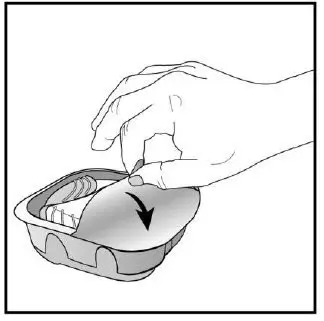 Figure A | 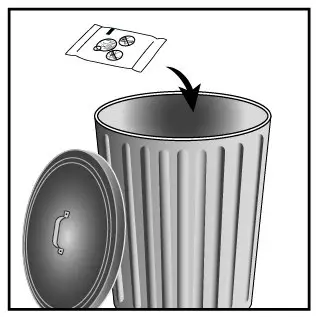 Figure B |
|
Important Notes:
Check the counter. See Figure C. |
|
 Figure C |
|
|
Prepare your dose: Wait to open the cover until you are ready to take your dose. |
|
 Figure D |
|
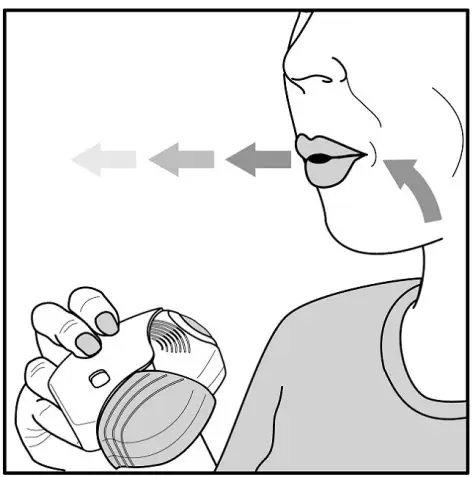 Figure E |
|
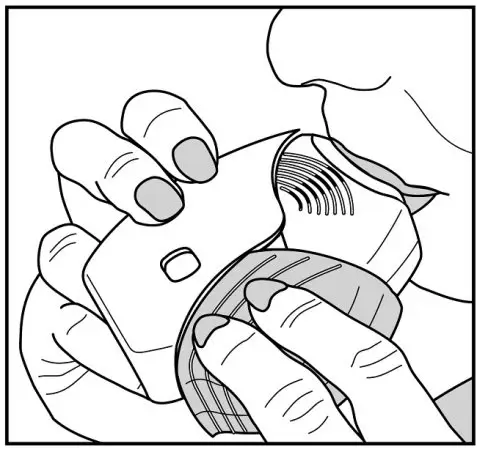 Figure F |
|
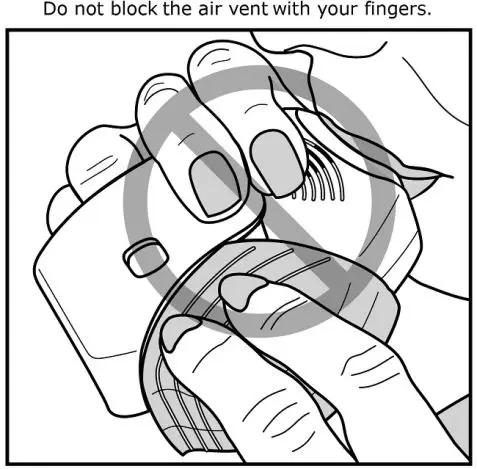 Figure G |
|
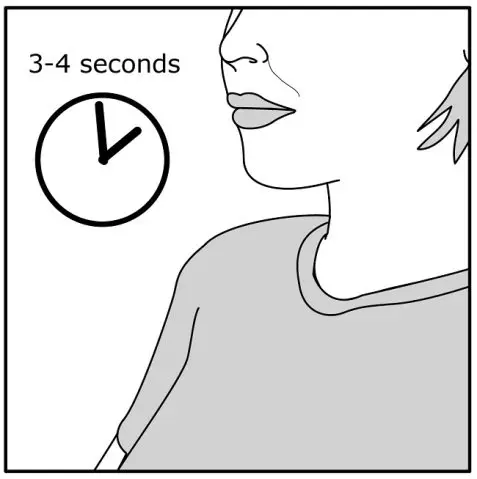 Figure H |
|
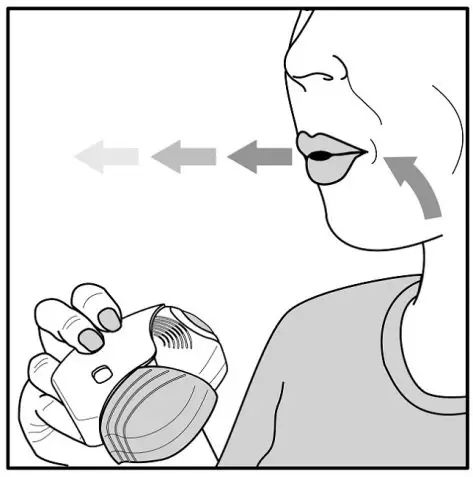 Figure I |
|
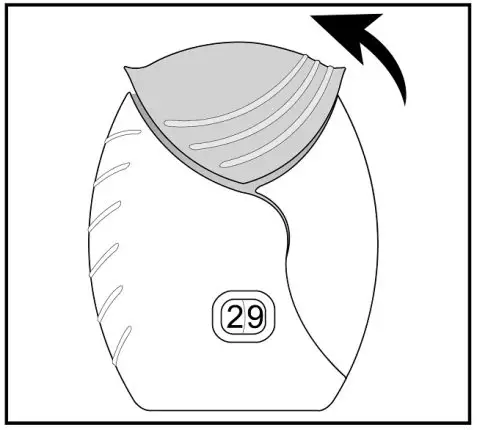 Figure J |
|
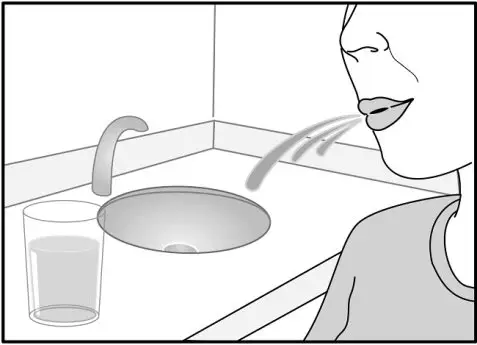 Figure K |
|
|
Important Note: When should you get a refill? |
|
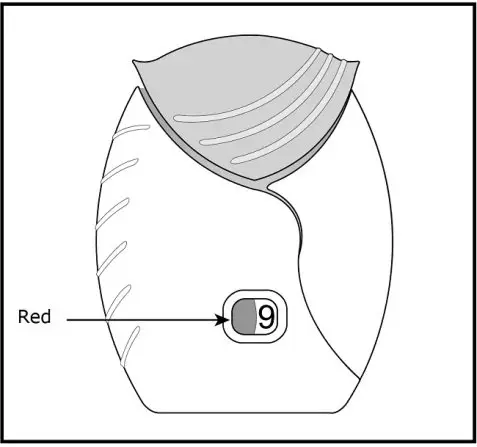 Figure L |
|
|
For more information about ARNUITY ELLIPTA or how to use your inhaler, call 1-888-825-5249. Trademarks are owned by or licensed to the GSK group of companies. GlaxoSmithKline, Durham, NC 27701 ©2023 GSK group of companies or its licensor. ARN:2IFU |
|
This Instructions for Use has been approved by the U.S. Food and Drug Administration Revised: March 2023
PRINCIPAL DISPLAY PANEL
NDC 0173-0888-10
ARNUITY ELLIPTA\
(fluticasone furoate inhalation powder)
50 mcg
Rx Only
FOR ORAL INHALATION ONLY
Each blister contains 50 mcg of fluticasone furoate and lactose monohydrate.
1 ELLIPTA Inhaler containing 1 Foil Strip of 30 Blisters
GSK
Made in Singapore
©2023 GSK group of companies or its licensor.
- 62000000087776 Rev. 4/23
PRINCIPAL DISPLAY PANEL
NDC 0173-0874-10
ARNUITY ELLIPTA
(fluticasone furoate inhalation powder)
100 mcg
Rx Only
FOR ORAL INHALATION ONLY
Each blister contains 100 mcg of fluticasone furoate and lactose monohydrate.
1 ELLIPTA Inhaler containing 1 Foil Strip of 30 Blisters
GSK
Made in Singapore
©2023 the GSK group of companies or its licensor.
- 62000000087842 Rev. 4/23
PRINCIPAL DISPLAY PANEL
NDC 0173-0876-10
ARNUITYELLIPTA
(fluticasone furoate inhalation powder)
200 mcg
Rx Only
FOR ORAL INHALATION ONLY
Each blister contains 200 mcg of fluticasone furoate and lactose monohydrate.
1 ELLIPTA Inhaler containing 1 Foil Strip of 30 Blisters
GSK
Made in Singapore
©2023 the GSK group of companies
- 62000000087779 Rev. 4/23
| ARNUITY ELLIPTA
fluticasone furoate powder |
||||||||||||||||||||
|
||||||||||||||||||||
|
||||||||||||||||||||
|
||||||||||||||||||||
|
||||||||||||||||||||
|
||||||||||||||||||||
| ARNUITY ELLIPTA
fluticasone furoate powder |
||||||||||||||||||||||||||||||
|
||||||||||||||||||||||||||||||
|
||||||||||||||||||||||||||||||
|
||||||||||||||||||||||||||||||
|
||||||||||||||||||||||||||||||
|
||||||||||||||||||||||||||||||
| ARNUITY ELLIPTA
fluticasone furoate powder |
||||||||||||||||||||||||||||||
|
||||||||||||||||||||||||||||||
|
||||||||||||||||||||||||||||||
|
||||||||||||||||||||||||||||||
|
||||||||||||||||||||||||||||||
|
||||||||||||||||||||||||||||||
| Labeler - GlaxoSmithKline LLC (167380711) |




